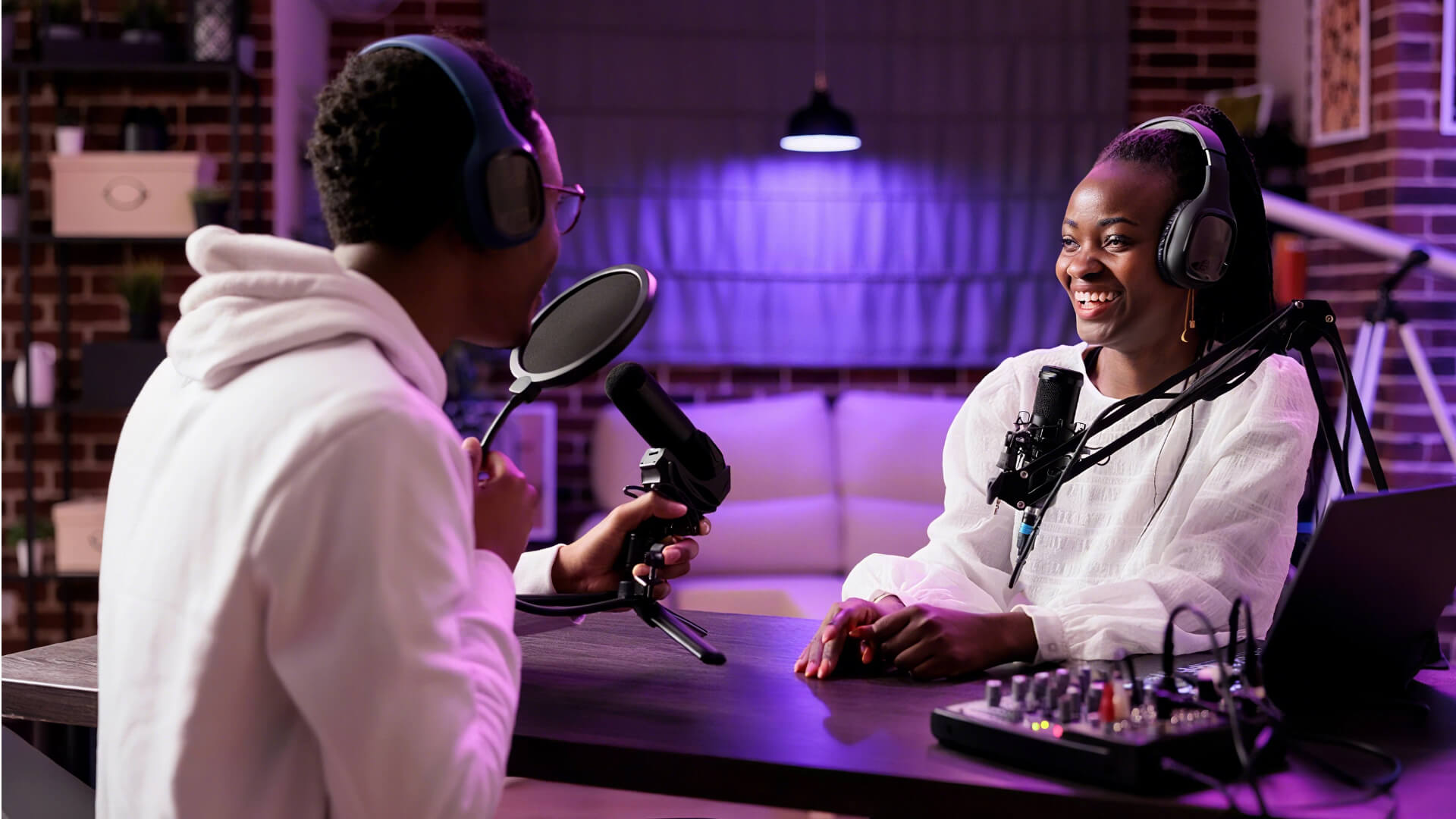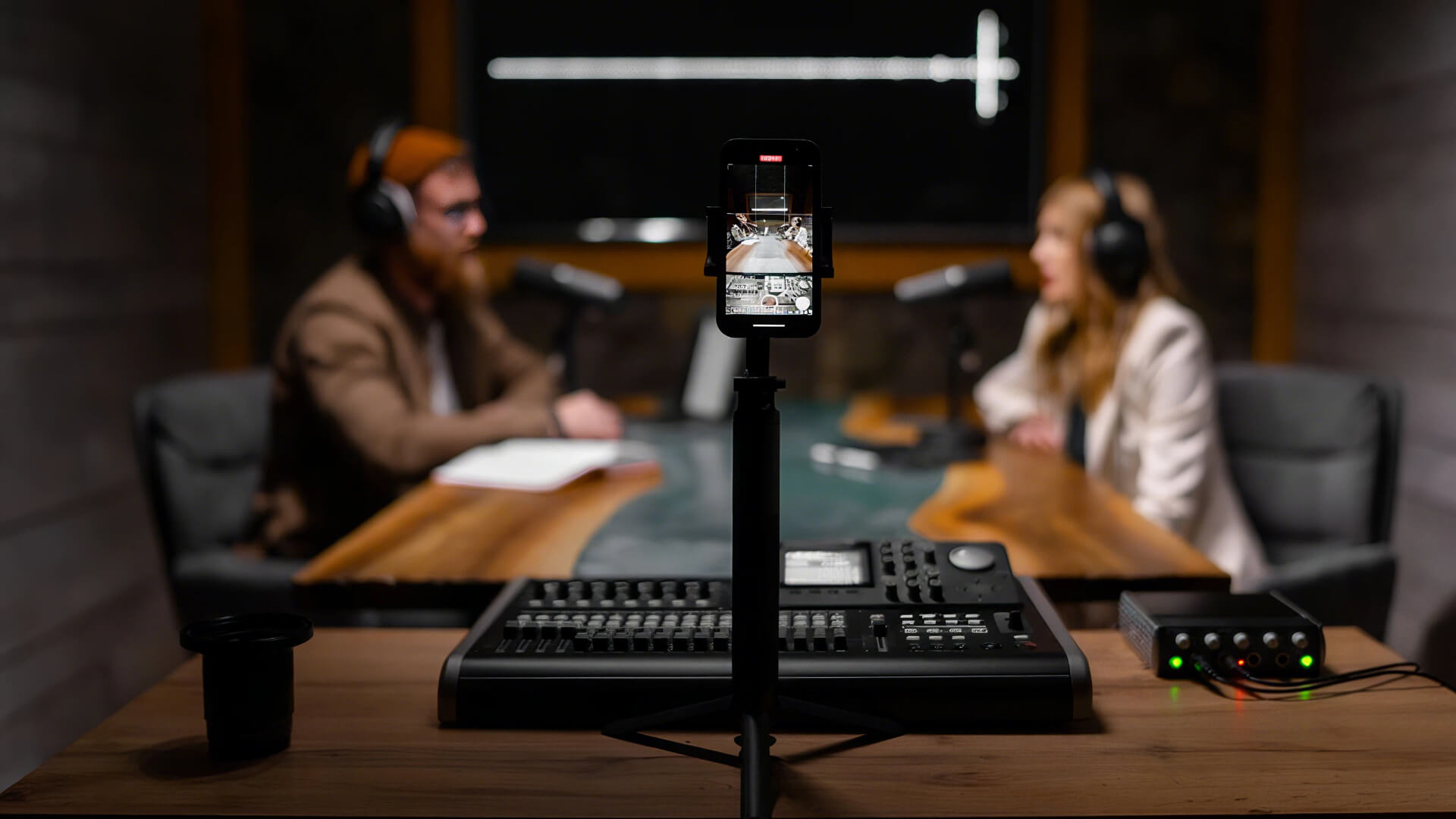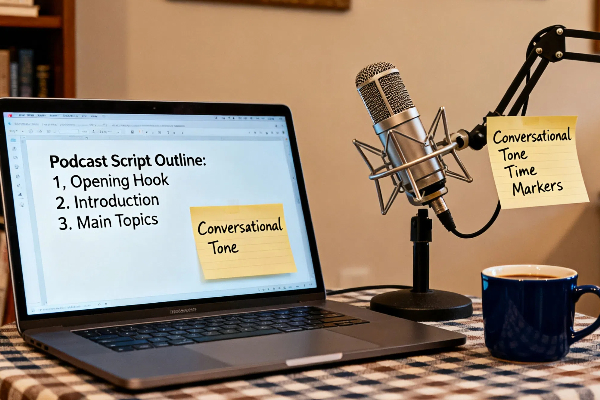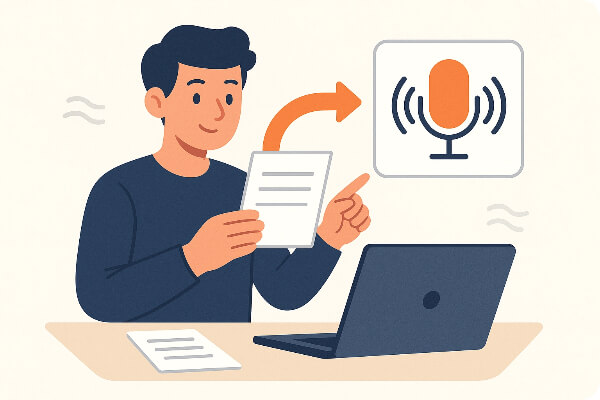Ultimate Guide To How To Create Engaging Podcast Episodes

The podcast industry is set to keep its strong growth momentum in 2025. The number of podcast listeners is expected to reach 584 million. At the same time, podcast channels are expanding rapidly. By 2025, there will be more than 4.52 million shows worldwide, releasing over 160,000 new episodes every month.
For creators, this presents both opportunities and challenges. On one hand, your podcast has the potential to reach more listeners than ever before. On the other, you’ll be competing with more creators for their attention.
In this competitive landscape, creating engaging podcast content is more important than ever. Great content draws listeners in, encourages interaction, and turns casual listeners into loyal subscribers. The more loyal fans you build, the more your podcast can stand out and grow.
What Readers Will Learn In The Guide
In this guide, we’ll walk you through how to create engaging podcast episodes step by step. You’ll learn practical content creation techniques, ways to increase your podcast’s visibility, and effective promotion strategies.
By the end of this article, you’ll have a set of actionable tips to plan your podcast episodes with more clarity and structure.
Let’s get started.
Understanding the Podcasting Landscape
Why Engagement Matters More Than Ever

As mentioned earlier, the podcast market is becoming increasingly competitive. Every day, listeners are presented with a massive amount of new podcast content. To ensure a great user experience, podcast platforms naturally want to recommend the best shows to their audiences.
So, what makes a podcast “good” in the eyes of the platform? One key factor is listener engagement. When people not only listen to a podcast but also like, comment, or subscribe, it shows that the content resonates with them emotionally.
Podcasts that spark this kind of interaction are seen by platform algorithms as higher-quality content. These shows help platforms keep users engaged over the long term. As a result, platforms are more likely to give them extra visibility and recommendations — which ultimately brings more subscribers to the podcast.
Types of Podcasts: Choosing What Fits Your Brand
The first step to creating engaging podcast content is choosing the right podcast format. Picking a format that matches your strengths and interests will give you the passion and ability to produce high-quality episodes consistently.
Here are some of the most common podcast formats:
Solo Podcast

In this format, there’s usually only one host who creates most of the content on their own. There are no guests, and the host typically dives deep into topics they’re passionate about or have expertise in, sharing insights and personal experiences with the audience.
Example: Dan Carlin’s Hardcore History
Interview Podcast

This format centers around conversations between the host and different guests. The host asks questions to draw out the guest’s perspectives, stories, and expertise. Each episode features a new guest, bringing fresh topics, styles, and viewpoints to the show.
Example: Guy Raz’s How I Built This
Video Podcast

A video podcast combines traditional audio with video elements. It records not only the conversation between the host and guests but also the setting, giving viewers a richer, more immersive experience. Audiences can both listen and watch, which can help increase engagement.
Example: Lex Fridman’s Lex Fridman Podcast
How to Creat Engaging Podcast Content
Define Your Target Audience and Niche

Before you start creating podcast content, it’s important to choose your podcast niche. Ideally, your niche should be something you’re genuinely interested in. If it’s also something you’re skilled at, even better.
Many people believe expertise matters more than passion, but I see it differently. Building a podcast is a long-term journey that requires consistency and perseverance. You’ll face challenges along the way, and without real passion for your niche, it’s hard to stay motivated.
Once you’ve defined your niche, the next step is to understand your audience. You need to build a clear picture of who they are, what they need, and the problems they want to solve within this niche. Knowing this helps you create content that truly resonates with them and meets their expectations.
Understanding your audience is a big topic, and it’s difficult to cover everything in just a few lines here. The two articles below are great resources to help you get started:
Brainstorming Episode Ideas That Resonate

Now it’s time to choose topics for your podcast episodes. There are many ways to find great ideas. Here are some of the most common sources:
- Listener Feedback: Check the comments on your own podcast and your competitors’ shows. See what questions listeners are asking and what topics spark the most interest. These are often great starting points for new episodes.
- Industry Trends: Every industry has its hot topics. For example, if your podcast is about football, big transfer news can be a perfect opportunity to create an episode discussing its potential impact.
- Personal Experience: Topics based on your own experiences are often overlooked, but they can be incredibly powerful. When you share real stories, your content naturally becomes more vivid and emotional. This personal touch makes your episodes more engaging and relatable for listeners.
- Evergreen Topics: Many niches have timeless subjects that people always care about. For example, in the fitness niche, topics like weight loss, muscle building, and diet planning are consistently relevant.
Creating Engaging Podcast Content Based on Your Topic

Once you’ve chosen your topic, the next step is to shape the actual content of your episode. So how do you make your podcast truly engaging? The key is to understand what your audience really cares about within that topic. There are two effective ways to do this:
Learn from Competitors
Studying your competitors is a powerful strategy. Look at the top-performing podcasts on the same topic and analyze what they’re doing. Pay attention to their format, the angles they use to approach the subject, and any unique or insightful points they bring up. Take notes — these observations can become valuable material when preparing your own episodes.
Go Where Your Audience Is
This method is even more direct. Visit the places where your target audience spends time, such as Reddit or Quora, and explore the discussions happening around your topic. Look at the questions people are asking and the issues they care about most.
You can also use platforms like YouTube to gather insights. Check the comment sections of videos related to your topic. The questions and discussions there are often very specific and can give you fresh ideas for your podcast. These “new angles” can help you fill content gaps and stand out from others in your niche.
How Different Podcast Formats Can Enhance Your Content
Once you’ve created engaging podcast content, the next step is to present it in the best possible way. The right format can make your content more dynamic, memorable, and enjoyable for listeners. Here are some tips for bringing your content to life through different podcast formats:
Solo Podcast Episodes

Solo episodes rely heavily on the host’s delivery. You need strong communication skills and a clear personal style to keep listeners engaged. It’s also important to showcase your unique perspective and voice throughout the episode.
To improve, study successful solo podcasters and pay attention to what makes their shows captivating — their tone, storytelling techniques, or the way they structure their episodes.
Interactive and Guest-Based Episodes

The magic of interview-style podcasts lies in their unpredictability. You can prepare questions and a rough outline, but the final outcome is often shaped by the interaction with your guest.
To make these episodes shine, invite guests who bring real value — industry experts, thought leaders, or people with fascinating stories. At the same time, craft thoughtful questions that spark meaningful conversations and encourage guests to share insights your audience truly cares about.
Crafting Episode Titles and Descriptions for Maximum Discoverability

Having great podcast content is just the first step. To reach more listeners, you need to optimize your episode titles and descriptions.
Follow SEO Best Practices
First, make sure your titles follow SEO guidelines. Include relevant keywords related to your podcast topic so users can easily find your episodes on podcast platforms. But don’t overstuff keywords — keep it natural and readable. For a deeper guide on podcast SEO, check out this article: SEO for Podcasts
Make Them Engaging
Having an SEO-friendly title helps people find your podcast, but to get them to actually click, your title and description need to spark real interest. Here are two examples:
Unengaging Title: “Episode 839: The Indicator Goes To California.”
This title simply states the episode’s content without giving listeners a compelling reason to tune in. It lacks a hook or intrigue.
Engaging Title: “Episode 858: Venezuela’s Fugitive Money Traders.”
This title uses dramatic language like “Fugitive,” hinting at crisis and conflict. It grabs attention and piques curiosity, making listeners more likely to click and listen.
Remember, your competitors can be your best teachers. Study the top podcasts in your niche to see how they craft titles and descriptions that attract and retain listeners.
Producing High-Quality Podcasts
Now that you have engaging podcast content, the next step is to ensure high-quality audio. To do this, you need the right recording equipment and effective podcast editing skills.
How to Choose Podcast Recording Equipment

Different podcast creators have different equipment needs. If you’re just starting out, an entry-level setup is enough to get started. For experienced podcasters, investing in more professional equipment can help improve audio quality and production value.
For a detailed guide on choosing the right podcast equipment, check out this article: What Equipment Do You Need for a Podcast?
How to Record and Edit a Podcast

Once you have the right podcast equipment, you’ll also need solid recording and editing skills. Learning these takes time and practice, and it’s a big topic to cover fully here. The following videos can help you get started:
If you don’t want to spend a lot of time learning audio editing, several AI podcast editing tools can help:
If recording and editing audio still feels too difficult, and you just want to experiment while minimizing trial-and-error, you can try AIPodify. With this tool, you simply enter text, and it generates podcast-ready audio you can upload to platforms. You can create solo episodes or interview-style podcasts. To learn more, check out this guide: How to Convert Text into Podcasts with AIPodify
Promoting Your Podcast
To reach more listeners and encourage interaction, you need to actively promote your podcast. Don’t rely solely on podcast platforms to push your episodes to users.
Channels for Podcast Promotion and Distribution
There are many platforms you can use to promote your episodes, including social media and email. You can even create a dedicated website for your podcast, like Lex Fridman does. This opens up more opportunities to drive traffic, such as through Google SEO, Google Ads, or Facebook Ads.
Encourage Interaction Within Your Community
If you have a community for your show, such as a Facebook group or Discord server, encourage members to interact with your podcast. This boosts engagement and gives you valuable feedback from real listeners.
Analytics and Performance Tracking
After running your podcast for a while, it’s important to analyze your data to understand how your episodes are performing. Key metrics to track include:
- Episode Plays: Measures popularity and reach. Helps identify which topics, titles, or episode lengths attract more listeners.
- Unique Listeners per Episode: Shows how many people listen to each episode. Helps determine whether growth comes from new listeners or repeat audience.
- Completion Rate / Average Listen Time: Indicates how engaging your content is and whether the structure works. Low completion rates may suggest shortening the episode or improving mid-episode pacing.
- Drop-Off Points: Pinpoints exactly when listeners stop listening. Use this insight to adjust content or pacing, such as editing or improving transitions.
- New vs Returning Listeners: Helps assess both audience acquisition and retention for each episode.
- Growth Rate: Tracks overall podcast growth. Useful for evaluating promotion efforts and long-term strategies.
- Social Interactions (Shares, Comments, Likes): Reflects listener engagement and willingness to spread your content. Consider adding interaction prompts or calls-to-share to boost organic reach.
Analyzing these metrics will help you identify weaknesses in your episodes. By iterating based on this data, you can continuously improve your content and create highly engaging podcasts that inspire listener interaction.
Building Long-Term Relationships with Your Listeners
Never view your listeners as just numbers—they are real people. If you want to grow your podcast long-term, you should build lasting relationships with them. Here are some ways to maintain strong connections with your audience:
- Community Groups: Communities are a powerful way to engage with your fans. You can interact with them beyond your podcast release schedule, discuss topics together, and build closer relationships.
- Live Streaming: Live sessions are a popular way to connect with listeners. They feel casual and approachable, allowing users to ask questions in real time and get immediate responses, which helps reduce distance between you and your audience.
- Exclusive Content: For subscribers or members, create special episodes or bonus content. This makes them feel valued and fosters loyalty to your podcast.
By using these strategies, you can deepen emotional bonds with your listeners. When new episodes are released, they’re more likely to engage with your content and even recommend your podcast to others.
Conclusion
In summary, creating a successful podcast goes beyond simply recording episodes. The key lies in producing content that is carefully tailored to your audience, maintaining high production quality, leveraging the right tools and technology, and continuously experimenting with new ideas. By focusing on these core areas—content customization, professional execution, smart use of technology, and innovative approaches—you can build a podcast that not only attracts listeners but also keeps them engaged and coming back for more.
Remember, the most successful podcasts combine creativity with consistency. By applying these principles, you’ll be well-equipped to grow your audience, foster meaningful interactions, and stand out in an increasingly competitive podcasting landscape.

How to Write a Podcast Script: The Complete Guide with Templates
A great podcast script is your secret weapon. It's the roadmap that transforms your ideas into a structured, engaging story, ensuring every moment captivates your audience. Far from just words on a page, a script—whether a detailed manuscript or a simple outline—banishes recording anxiety and streamlines editing, letting you focus on delivering a powerful, professional show.

How To Turn Notes Into A Podcast With AIPodify
Have you ever taken valuable notes during work, study sessions, or meetings that you wished more people could see and learn from? In recent years, podcasts have become one of the most popular ways to share ideas and reach new audiences. So why not turn your notes into a podcast?